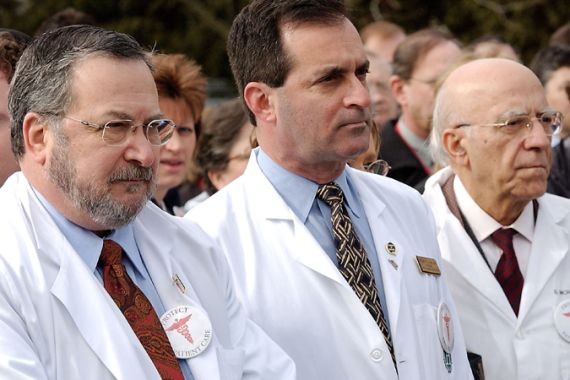American doctors terrified of litigation
The threat of lawsuits negatively impacts not only the doctor-patient relationship, but patient care in general.

 |
| Malpractice premiums in high-risk specialties, such as neurosurgery, can be up to $140,000 per year [GALLO/GETTY] |
Chicago, IL – Imagine that you are floating in a small raft, in the middle of the ocean, with a fiery sun beating down on your back. There is one other person in the raft, who is thirsty, so you give him the only bottle of water available. He chokes on the water and develops pneumonia. When you are rescued two days later, your companion goes to your boss, and tells him you should be fired and they compensated.
Welcome to the world of medical malpractice.
Keep reading
list of 4 itemsSouth Africa’s Ramaphosa signs health bill weeks before election
Gaza lost much more than a hospital when it lost al-Shifa
With measles on the rise, rebuilding trust in vaccines is a must
Not much is supposed to scare the modern American physician. After all, they work in a complex environment of growing specialisation, within an ever-changing practice landscape. They deal with matters of life and death on a daily basis. Despite statistics by the WHO that put the overall US healthcare ranking among the lowest for western democracies, American physicians are widely regarded as the best in the world, with excellent use of the latest medical evidence in their practice.
|
“There is something that is on the mind of every American physician, every single day – the threat of litigation.” |
Yet, there is something that is on the mind of every American physician, every single day – the threat of litigation.
It is difficult to understate the effect this has on the collective psyche of physicians. Even family practitioners, who are sued the least of any specialty, can expect at least a 40 per cent likelihood that they will be taken to court in their career. For high-risk specialties such as obstetrics and neurosurgery, litigation is accepted as a matter of when, not if. Indeed, malpractice premiums of $140,000 per year are not unheard of in these fields.
The terror of litigation
Being sued is a traumatic event in the life of a physician. For one thing, physicians must deal with the possibility that they failed the patient in some way – the very person they are sworn, and trusted, to protect.
There are multiple meetings with defence lawyers, and possibly the prosecution, which are disruptive and time-consuming for physicians, who often work 60 hours a week or more. At the end, there is the courtroom, where 12 jurors who have little medical experience wait to judge the physician. The prosecution pays handsomely for expert witnesses to support their case against the defendant. It is thus no surprise that many litigation cases end in a cash settlement without the trauma of the courtroom.
|
“One or two successful lawsuits, whether justified or not, can destroy a physician’s career… Against this backdrop, one can easily understand where the term ‘defensive medicine’ comes from.” |
In some counties in the US, if a physician is found guilty of malpractice, the prosecution can go after their assets, including savings and homes. Malpractice suits also affect the ability to get on staff at other hospitals, referrals from insurance companies, and licencing in other states. One or two successful lawsuits, whether justified or not, can destroy a physician’s career. At the very least, these lawsuits change the prism through which the physician views patient care.
Against this backdrop, one can easily understand where the term “defensive medicine” comes from. It is impossible for a physician in the US to examine and diagnose even a single patient without considering the possibility of litigation.
This fear of lawsuits permeates every aspect of medicine. Physicians document patient visits, knowing that a judge can subpoena their clinical notes. They are careful when corresponding with patients or their peers via e-mails or text messages, knowing that these can also be subpoenaed. The effect this might have on patient care is hard to know.
What is easier to measure is the effect on the costs of the healthcare system. Patients with back pain often end up with an expensive MRI (Magnetic Resonance Imaging), rather than less costly options. The MRI is so sensitive that it is capable of detecting abnormalities in the human spine that have no clinical significance. However, ignoring an abnormality could later result in a lawsuit. So, many of these patients are then referred to surgical subspecialists, who may order their own tests, or refer these patients for injections or procedures to avoid lawsuits themselves.
‘Don’t get sued’
So what, you ask? Well, the patient then learns that invasive testing and procedures are the only valid way to treat their condition. They become less willing to accept more conservative treatment measures. It makes sense that they would then advise their acquaintances to get MRIs if they have back pain. As every physician knows, if a patient enters the office insistent on a particular test, it is too dangerous from a liability standpoint to ignore his/her requests. Ordering the MRI is easier, and legally more astute, than spending several minutes counselling the patient as to why the MRI is not helpful.
Since studies have shown that patients tend to sue doctors they don’t like, disagreeing with a patient too strongly is a surefire way to increase a physician’s legal liability; after all, lawsuits can shorten a physician’s career. If a physician sees 5,000 patients a year, shortening their career by a few years means that tens of thousands of patients will never get the benefit of seeing that physician. One can see how justifiable it becomes for a doctor to just do whatever the patient wants – even if it isn’t the best decision for that particular patient.
|
“Things have gone too far. Doctors routinely stop seeing patient populations that they perceive as high-risk. They order unnecessary tests to protect themselves from lawsuits. The patient-doctor relationship is put under tremendous strain.” |
Supporters of patient rights often claim that litigation is the best way to protect those rights. They are correct – to a point. Medical errors occur, and if the error is a result of negligence or poor medicine that results in harm to the patient, it is appropriate to compensate that patient. But things have gone too far. Doctors routinely stop seeing patient populations that they perceive as high-risk. They order unnecessary tests to protect themselves from lawsuits. The patient-doctor relationship is put under tremendous strain. Those who would argue for litigation as the best method to hold doctors accountable, simply do not understand the everyday practice of healthcare.
Instead, the lawsuit has become the go-to method for conflict resolution, while physicians feel more like commodities and less like human beings. Most patients have no idea how the rampant litigation in the medical field affects their doctors, and their own health, and more importantly for society – the public good.
Medical professionals who practice in other countries may be shocked by the degree to which the proverbial sword of litigation hangs over the head of every American doctor. They have good reason – this is, for now, the way that American society has chosen to deal with conflicts within the doctor-patient relationship.
“Do no harm” is the first thing taught to every medical student. It is a shame that this impressionable and idealistic group of young people is also learning the first lesson of modern medicine in the United States: “Don’t get sued”.
Dr Yasser Said is a board certified physician practicing in the United States.
